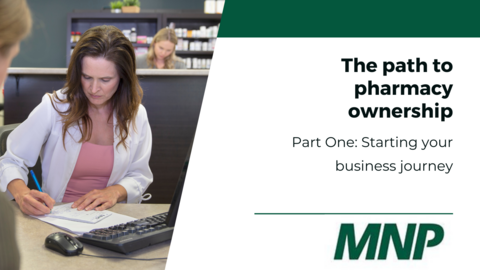
The path to pharmacy ownership: Part one

This article originally appeared on the MNP website. Image credit: The Images of Pharmacy Practice Project | EPICORE Centre & Jim Dobie Photography
by Jim Chagnon, CPA, CA, TEP, Partner, Private Enterprise Professionals
In this three-part series, we’ll explore what it takes to become a pharmacy business owner, how plans and needs change over time, and navigating through each stage with confidence.
Part One: Starting your business journey
Your professional life is a process rather than an event, one that sees you grow from student to practitioner, and ultimately to retirement. A typical lifecycle in pharmacy ownership goes through four phases:
Foundational – Setting the fundamental preparations required to establish a solid base for your business future, facilitating growth in a stable, viable manner.
Growth – Where you address a wide range of needs faced by the business, including financial information systems, technology, human resources, financing, and operations.
Established – Here is where you start focusing on protecting all the value you have created and how you will realize the value you have built when you finally do exit.
Transition – This is the process of divesting of your holdings and then planning for the management and transfer of that wealth within your family requires serious attention.
First steps
You’ve transitioned from student to practicing pharmacist and are looking into what you need to take that step into pharmacy ownership. Key to starting any business is the business strategy and plan. Your strategy is a high-level view of what you need to do to achieve your goal, and includes a business plan, financial modeling, an advisory team, and an exit plan (yes, more on that below).
Business plan - Creating a business plan makes you look at where you are going and how you will get there – in detail. If you need to go to the bank for financing, you will need a business plan to show them you have thought this through and have a sound business model.
More importantly, a business plan will help prove to yourself the business is viable, and you don’t needlessly waste your time and money pursuing a venture that will not work. A business plan should cover off key aspects, including:
- Financial
- Operational
- Technology
- Human resources
- Marketing
Financial modeling - A key document in the initial stages of the business plan, a financial model is used to determine if the business is viable or not. It should include:
- Earnings forecasts - How much revenue will I generate in the first year to three years? When will I show a profit?
- Cash flow projections - How much will I need to inject and or borrow as the business gets on its feet and when? Have you included best case, worst case, and most likely scenarios?
- Debt service calculations - Will the business be able to pay the bank on time? What are best case, worst case, and most likely scenarios?
- Shareholder Compensation - Will the business be able to afford to pay me, as an active business owner, and still provide a return on my investment?
Advisory team - As a professional, you should focus on what you know and are really good at and rely on others to help you with the things they know and are really good at. A solid team of advisors include an accountant, a lawyer, a lender, financial advisor and an insurance advisor. Ensure they are all working together as a team, supporting you through collaboration.
Exit Strategy - You likely won’t know for sure what this end game will look like, but you have to start contemplating it early on if you want to achieve it. An exit plan makes you consider questions like how long do I want to do this for? What’s the end game? And how do I get out?
Going through your exit plan objective will also play into how to set up your corporate tax structure early on so you can minimize your taxes and get the most out of opportunities.
Pitfalls to Avoid
Now that you can see the path, here are a couple of roadblocks to avoid at the beginning of your business journey:
Insufficient planning and not early enough: This usually results in increased costs and missed opportunities. For example, don’t sign a five-year lease without a proper business plan that shows value to committing to a long-term location.
Not engaging a full advisory team to cover off all areas: Do what you do best and engage experts to cover off the other areas. Engaging experts to cover off business risks and advice can minimize risks to the business and the shareholders. Experts will help you maximize your opportunities while minimizing your risks.
Find out the state of the market and how to plan an acquisition in Part Two of The path to pharmacy ownership series. And for more information, contact Jim Chagnon, CPA, CA, TEP, at 289.293.2311 or jim.chagnon@mnp.ca.